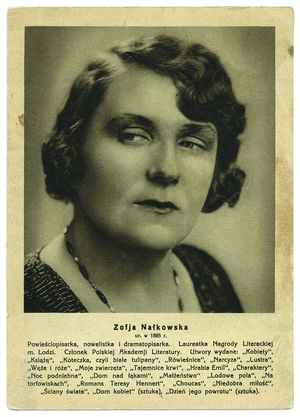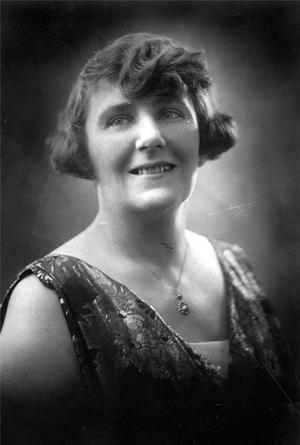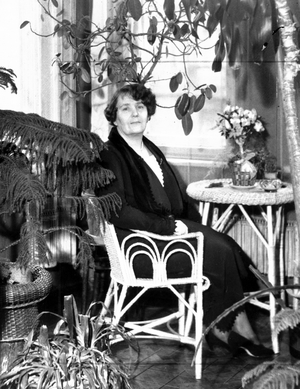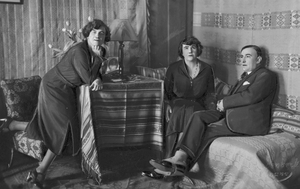Zofia Nałkowska was born in 1884 in Warsaw, to a family belonging to the left-wing intelligentsia. She graduated from the Aniela Hoehne’s finishing school and the Flying University. She made her debut in 1898 with a poem titled “Pamiętam” (I Remember) printed in Przegląd Tygodniowy. In 1896 Zofia Nałkowska began writing diaries (Dzienniki), which she continued to write with some interruptions for nearly sixty years (until her death in 1954 roku), and which diaries became an archive of a life lived against a historical background. She became famous thanks to her novels. She made her prose debut in 1906 with Kobiety. The most important novels include Hrabia Emil, Romans Teresy Hennert, Dom nad łąkami, Granica, Niecierpliwi.
In 1907 during the First Polish Women’s Convention she gave a paper titled “Uwagi o etycznych zadaniach ruchu kobiecego”, [Comments on the Ethical Tasks of the Women’s Movement] which caused a scandal. She demanded the liberation of women from the ideal of moral purity established by men. She was married twice, first in 1906–1918 to a poet Leon Rygier, and then in 1922–1929 to an officer of Józef Piłsudski’s Legions, Jan “Jur” Gorzechowski. Both marriages failed.
After World War II, Nałkowska joined the Main Committee for the Investigation of the Nazi War Crime (Główna Komisja Badania Zbrodni Hitlerowskich), which resulted in Medaliony. In 1947–1952 she was an MP toParliament. She died on 17 December, 1954 in Warsaw.
In the 1930s Nałkowska mentored a number of young writers and helped them enter the literary world. Her circle included, among others: Tadeusz Breza, Michał Choromański*, Pola Gojawiczyńska*, Bogusław Kuczyński, Adolf Rudnicki* and Bruno Schulz. It is as ayoung and aspiring author that Schulz visited Nałkowska 16 April 1933 in her apartment at 4 Marszałkowska Street* in Warsaw*, asking her to read the manuscript of The Cinammon Shops. Nałkowska loved the book and immediately undertook every effort to publish it with the Publishing Society “Rój”*. In a gesture of gratitude in February 1934 Schulz sent Nałkowska a copy of The Cinammon Shops, which he bound and illustrated himself, with a personal dedication. The book was destroyed by Nałkowska’s jealous partner Bogusław Kuczyński (see 20 July 1935).
Their friendship, which began in April 1933 continued thanks to correspondence (see11 July 1933) and visits, which Schulz paid Nałkowska both in Warsaw and her house in Górki*. In April 1934, during Schulz’s visit in Warsaw, the friendship transformed into an erotic relationship; in Dzienniki Nałkowska writes about “a single night spent together”. The relationship ended quickly as, in May, Nałkowska became involved with her secretary, Bogusław Kuczyński.
In 1933–1934 Nałkowska often wrote about Schulz’s worship and adoration. Initially she accepted and appreciated these gestures but with time, by May 1934, she began to notice an inconsistency with acceptance, and noted also her feelings for Kuczyński. “Oh, the dear one, who does not know yet. Certainly I am not the essence of his existence as it might seem from his letters, from his pretty words. It was not even called love. Rather it was worship, giving praise to me. And it originated not in myquality, not only in it, but in his nature, craving to be humbled and lost in adoration and finally finding some objective ground […]. I am using the past tense but it is still there. Only I am not in this place anymore”. Schulz himself called Nałkowska his “protectress and, I think I can say that, a friend”; on another occasion, he also mentioned his friendship with Nałkowska.
In later years Schulz met with Nałkowska in Warsaw several times (see 1 January 1936, 23 January 1936, 4 February 1936, 15 July 1936). He also published in Studio*, a journal edited by Kuczyński. Schulz and Nałkowska met for the last time in June 1939 during Nałkowska’s stay in a sanatorium in Truskawiec*.
Nałkowska was informed about Schulz’s death by Ryszard Matuszewski before 27 January 1943 (on that day Nałkowska already thought of Schulz as already dead). In the first two editions of Regiony Wielkiej Herezji Jerzy Ficowski writes about Nałkowska’s involvement in a plan to kidnap Schulz from the ghetto in Drogobych. However, in the 1992 edition he considers this story to be unbelievable.
After the war Nałkowska wrote about Schulz a number of times in her diaries, considering his lossto be particularly painful. She mentions several meetings devoted to Schulz: with an Italian Schulz enthusiast, a member of a delegation of Italian writers named Toricco, a disappointing meeting with Professor Stefan Szuman, and Jerzy Ficowski’s visits in the 1950s, during which she read his article and gave him materials concerning Studio.
In“Wprowadzenie do Księgi Listów” Jerzy Ficowski suggests that Schulz’s letters to Nałkowska were destroyed during the Warsaw Rising. However, as Bogusław Kuczyński’s letters to Ficowski’s from the 1950s indicate, the letters still existed after the war; what is more Nałkowska read them to Ficowski. They became lost only after they were given to an unknown person to be copied. (mr)





